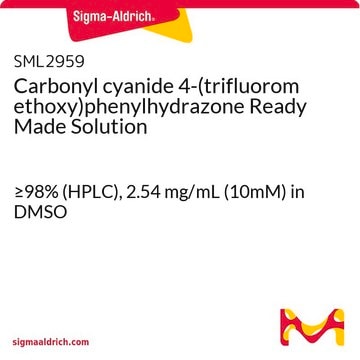C2920
Carbonyl cyanide 4-(trifluoromethoxy)phenylhydrazone
≥98% (TLC), powder, Mitophagy inducer
Synonim(y):
FCCP, Mesoxalonitrile 4-trifluoromethoxyphenylhydrazone
About This Item
Polecane produkty
product name
Carbonyl cyanide 4-(trifluoromethoxy)phenylhydrazone, ≥98% (TLC), powder
Poziom jakości
Próba
≥98% (TLC)
Postać
powder
kolor
yellow
mp
174-175 °C (dec.) (lit.)
rozpuszczalność
95% ethanol: soluble
temp. przechowywania
2-8°C
ciąg SMILES
FC(F)(F)Oc1ccc(N\N=C(/C#N)C#N)cc1
InChI
1S/C10H5F3N4O/c11-10(12,13)18-9-3-1-7(2-4-9)16-17-8(5-14)6-15/h1-4,16H
Klucz InChI
BMZRVOVNUMQTIN-UHFFFAOYSA-N
Szukasz podobnych produktów? Odwiedź Przewodnik dotyczący porównywania produktów
Opis ogólny
Zastosowanie
Hasło ostrzegawcze
Danger
Zwroty wskazujące rodzaj zagrożenia
Zwroty wskazujące środki ostrożności
Klasyfikacja zagrożeń
Acute Tox. 4 Oral - Aquatic Chronic 4 - Eye Dam. 1 - Skin Corr. 1B - Skin Sens. 1
Kod klasy składowania
6.1A - Combustible acute toxic Cat. 1 and 2 / very toxic hazardous materials
Klasa zagrożenia wodnego (WGK)
WGK 3
Temperatura zapłonu (°F)
Not applicable
Temperatura zapłonu (°C)
Not applicable
Środki ochrony indywidualnej
Eyeshields, Faceshields, Gloves, type P2 (EN 143) respirator cartridges
Certyfikaty analizy (CoA)
Poszukaj Certyfikaty analizy (CoA), wpisując numer partii/serii produktów. Numery serii i partii można znaleźć na etykiecie produktu po słowach „seria” lub „partia”.
Masz już ten produkt?
Dokumenty związane z niedawno zakupionymi produktami zostały zamieszczone w Bibliotece dokumentów.
Klienci oglądali również te produkty
Produkty
DISCOVER Bioactive Small Molecules for Nitric Oxide & Cell Stress Research
Nasz zespół naukowców ma doświadczenie we wszystkich obszarach badań, w tym w naukach przyrodniczych, materiałoznawstwie, syntezie chemicznej, chromatografii, analityce i wielu innych dziedzinach.
Skontaktuj się z zespołem ds. pomocy technicznej












